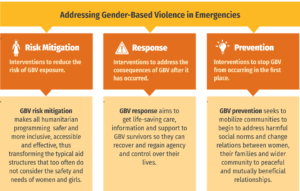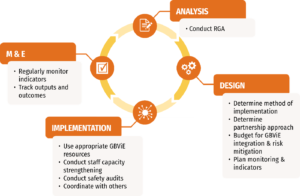Gender-based Violence in Emergencies
Gender-based Violence (GBV) takes many forms in times of crisis, both in private and public life. The prevalence and risks of GBV increase as existing gender inequalities are exacerbated by the chaos and tensions within households, communities, and society.
Crises often lead to increased levels of intimate partner violence; sexual violence as a tactic of war; sexual assault or exploitation during displacement; child, early and forced marriages; denial of resources; increase in harmful traditional practices; and sexual exploitation and abuse by humanitarian aid workers, peace-keepers and security forces.
During an emergency and its aftermath, access to lifesaving care and support is unpredictable, vulnerability to violence is higher, and systems that protect women and girls, including family, community and state structures, may weaken or break down.
Prevailing evidence and research dictate that GBV occurs in all emergencies worldwide, so we do not wait to prove GBV is occurring before taking action.
CARE believes gender inequality is at the root of all GBV. In humanitarian settings, where structures, systems and all support for women and girls are interrupted or have broken down, we believe it is vital to continue our focus on building agency, changing relations and transforming structures throughout our programs.
Ending GBV in Emergencies is a core pillar of CARE’s approach to Gender in Emergencies.
In line with all GBV programming within CARE, our programmatic approach to addressing GBV in Emergencies focuses on GBV risk mitigation, response and prevention.
Risk Mitigation
- Risk mitigation aims to identify GBV risks and take specific actions to reduce the immediate risk of exposure to GBV.
- Risk mitigation actions are the responsibility of ALL staff across ALL sectors in humanitarian response.
Response
- GBV response in emergency settings aims to establish or strengthen service delivery to support survivors and victims of violence.
- GBV response should only be conducted by trained GBV specialists.
Prevention
- GBV prevention aims to stop GBV from happening by addressing the root causes of violence and inequality.
- GBV prevention activities should only be conducted by trained GBV specialists.
GBViE risk mitigation actions can be performed by non-GBV specialist staff while GBViE response and prevention interventions require GBV specialized staff. View the full GBViE Guidance Note a for further information.
All staff have a responsibility to respond appropriately to disclosures of GBV. The GBV Pocket Guide is a useful resource on how to support a survivor who reports an incident when there are not GBV actors in the area.
In an emergency setting, CARE aims to include all three pillars—risk mitigation, response and prevention—in our programming. These may be implemented in different ways through a range of projects and partnerships appropriate to the context and program focus. How GBV is incorporated will depend on the focus of each project. At minimum ALL projects should include GBV risk mitigation actions.
Method of implementation: GBViE-focused
Projects that have a primary outcome of addressing GBViE with explicit prevention, response and/or risk mitigation objectives.
- Example: A project to establish women’s and girls’ safe spaces which provide life skills activities, psycho-social support and case management services.
- Example: A project which aims to ensure crisis-affected women and girls have improved access to GBV specialized services.
- Example: A project which aims to ensure women and girls in affected communities have access to a strengthened protection environment.
Team requirements: Project team of GBViE specialists.
Method of implementation: GBViE-included
Projects that have a primary outcome in other impact areas and include GBViE prevention and/or response integrated into or additional objectives.
- Example: A sexual/reproductive health project which includes clinical management of rape in its service delivery and resources specialized staff to provide this service.
- Example: A primary health care project which includes provision of GBV Case management services in its health clinic and resources specialized staff to provide this service.
Team requirements: GBViE specialist(s) as part of the project team, if a GBV specialist is not already in the CO. Support may also be provided through regional and global GBViE Specialists and/or through the Rapid Response Team.
Method of implementation: GBViE-focused
All projects should include GBViE risk mitigation actions regardless of the project outcomes.
- Example: An economic empowerment project utilizing market-based approaches and cash vouchers does a safety audit with women to figure out access and safety issues to markets.
- Example: A WASH project includes consultations with women about placement and management of water facilities
Team requirements: Does not require GBViE specialists in the project team. However, it is advised that project leads coordinate and seek guidance from GBV specialists in country or at regional/global level.
CARE takes an intersectional approach to addressing GBV in Emergencies to ensure we serve the most vulnerable in each context in which we work. We seek to see and understand diverse groups of women and girls based on their context and design programs based on understanding of the unique needs of these groups.
We work in close partnership with crisis-affected women and girls and their organizations, networks, women-led and women’s rights organizations, and other organizations promoting gender equality to ensure CARE’s efforts are guided by local women and girls’ voices and priorities. We aim to strengthen their capacity to lead GBV response and prevention activities. We also partner with those delivering services, whether government institutions, CSOs, NGOs, UN agencies, private sector organizations, to ensure services meet the needs of women and girls.
CARE coordinates with other humanitarian actors through the UN Humanitarian Cluster systems. CARE participates in the GBV Area of Responsibility (AoR) within the Global Protection Cluster at global, regional & country levels. CARE sits in the global GBV Guidelines Reference Group, in the global GBV AoR and hosts the Global Inter-agency GBV Guidelines Coordinator.
All humanitarian staff across all sectors have two key responsibilities in relation to GBV:
- Be prepared to respond appropriately to disclosures of GBV
- Identify GBV risks and take action to integrate GBV risk mitigation strategies into projects across all impact areas.
GBViE risk mitigation actions can be performed by non-GBV specialist staff. However, GBViE response and prevention interventions require GBV staff with specialist knowledge and skills.
GBViE risk mitigation, response and prevention actions should be planned and implemented throughout the project cycle.
ANALYSIS
- Conduct a Rapid Gender Analysis
DESIGN
- Determine method of implementation → See Section 3 on How we implement GBViE programs
- Determine partnership approach → See the Equitable Humanitarian Partnership Toolkit
- Budget for GBViE integration & risk mitigation → See CARE’s Checklist for Integrating GBV Risk Mitigation into Proposals
- Plan monitoring & indicators → See CARE’s GBViE Guidance Note and the MEAL section of CARE’s Emergency Toolkit
IMPLEMENTATION
- Use appropriate GBViE resources → See CARE’s GBViE Guidance Note and Section 7 on Key Tools
- Conduct staff capacity strengthening
- Conduct safety audits
- Coordinate with others
M&E
- Regularly monitor indicators
- Track outputs and outcomes
- CARE’s GBViE Guidance Note aims to help staff understand how CARE approaches GBV in emergency settings and what resources are available to support programming. This guidance includes:
- The Inter-agency Minimum Standards for Gender-Based Violence in Emergencies Programming guide GBViE response and prevention interventions.
- The IASC Guidelines for Integrating Gender-Based Violence Interventions in Humanitarian Action guide GBViE risk mitigation actions. These are commonly referred to as the IASC GBV Guidelines.
- The GBV Pocket Guide guides all humanitarian actors on how to support a survivor who reports an incident when there are not GBV actors in the area.
- Gender-Based Violence Hub on CARE Shares
- CARE’s Rapid Gender Analysis overview and RGA tools
- CARE’s Women Lead in Emergencies overview and Guidance Note Series
- GBViE resources in other languages:

Women and Girls’ Safe Spaces are a key strategy for the protection and empowerment of diverse women and girls affected by humanitarian crisis. This Promising Practices Guide outlines why WGSS are an important part of CARE’s GBViE programming and what teams need to know about establishing and managing WGSS. dddsafdssdf




